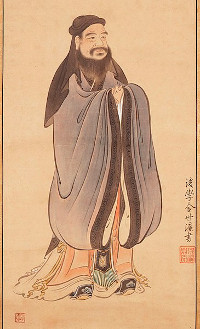

I Ching Explorer


-
☯I Ching Basics
-
☯Consulting I Ching
-
☯Chinese Zodiac
-
☯I Ching Resources
-
If you like our web site and find it useful - donate with PayPal to support new development
I Ching - Brief History
64 hexagrams of I Ching are credited to 4 ancient sage men – Fu Xi, King Wen, Duke of Zhou and Confucius.
These 4 ancient sages play different, however very important roles in I Ching history.
- Fu Xi - discovered 8 trigrams.
- King Wen - discovered 64 hexagrams and wrote their names and judgements (comments) to each hexagram.
- Duke of Zhou - wrote the line comments to each of 64 hexagram.
- Kong Qui (Confucius) - wrote his famous "Ten Wings" - philosophical comments to I Ching.
 Tradition says, that legendary Fu Xi (Fu Hsi) (2953 -2838 B.C.) – ancient sage and later emperor of China - brought I-Ching philosophy to Chinese people for more than 5,000 years.
He has created his original 8 trigrams when walking on the bank of Yangtze River and reflecting on eight segments of the shell of giant Chinese turtle (also known as a river dragon). He immediately realized their symbolic value and importance for agriculture.
Tradition says, that legendary Fu Xi (Fu Hsi) (2953 -2838 B.C.) – ancient sage and later emperor of China - brought I-Ching philosophy to Chinese people for more than 5,000 years.
He has created his original 8 trigrams when walking on the bank of Yangtze River and reflecting on eight segments of the shell of giant Chinese turtle (also known as a river dragon). He immediately realized their symbolic value and importance for agriculture.
 Much later – about the 12th century B.C. - King Wen, being at that time imprisoned in a solitary confinement, created 64 binary images of hexagrams by combining trigrams and re-arranging them in a special way.
Originally all hexagrams were created by King Wen without hexagram names and comments for them.
Later on he has added names and his explanations (so-called judgments) to each of 64 hexagrams, bringing I Ching to the mainstream.
Much later – about the 12th century B.C. - King Wen, being at that time imprisoned in a solitary confinement, created 64 binary images of hexagrams by combining trigrams and re-arranging them in a special way.
Originally all hexagrams were created by King Wen without hexagram names and comments for them.
Later on he has added names and his explanations (so-called judgments) to each of 64 hexagrams, bringing I Ching to the mainstream.
 Duke of Zhou (also known as a God of Dreams), the younger brother of King Wen of Zhou, wrote the line comments to each of 64 hexagram.
His work produced a first devination-ready version of I Ching making him a cultural hero of China of that times.
Duke of Zhou (also known as a God of Dreams), the younger brother of King Wen of Zhou, wrote the line comments to each of 64 hexagram.
His work produced a first devination-ready version of I Ching making him a cultural hero of China of that times.
 Finally, about 6th century B.C. legendary Chinese philosopher Confucius (551 – 479 BCE) wrote his famous commentaries –
known now as Ten Wings - to the whole I Ching and to all 64 individual hexagrams in it.
The I Ching as we know it now was born.
Finally, about 6th century B.C. legendary Chinese philosopher Confucius (551 – 479 BCE) wrote his famous commentaries –
known now as Ten Wings - to the whole I Ching and to all 64 individual hexagrams in it.
The I Ching as we know it now was born.